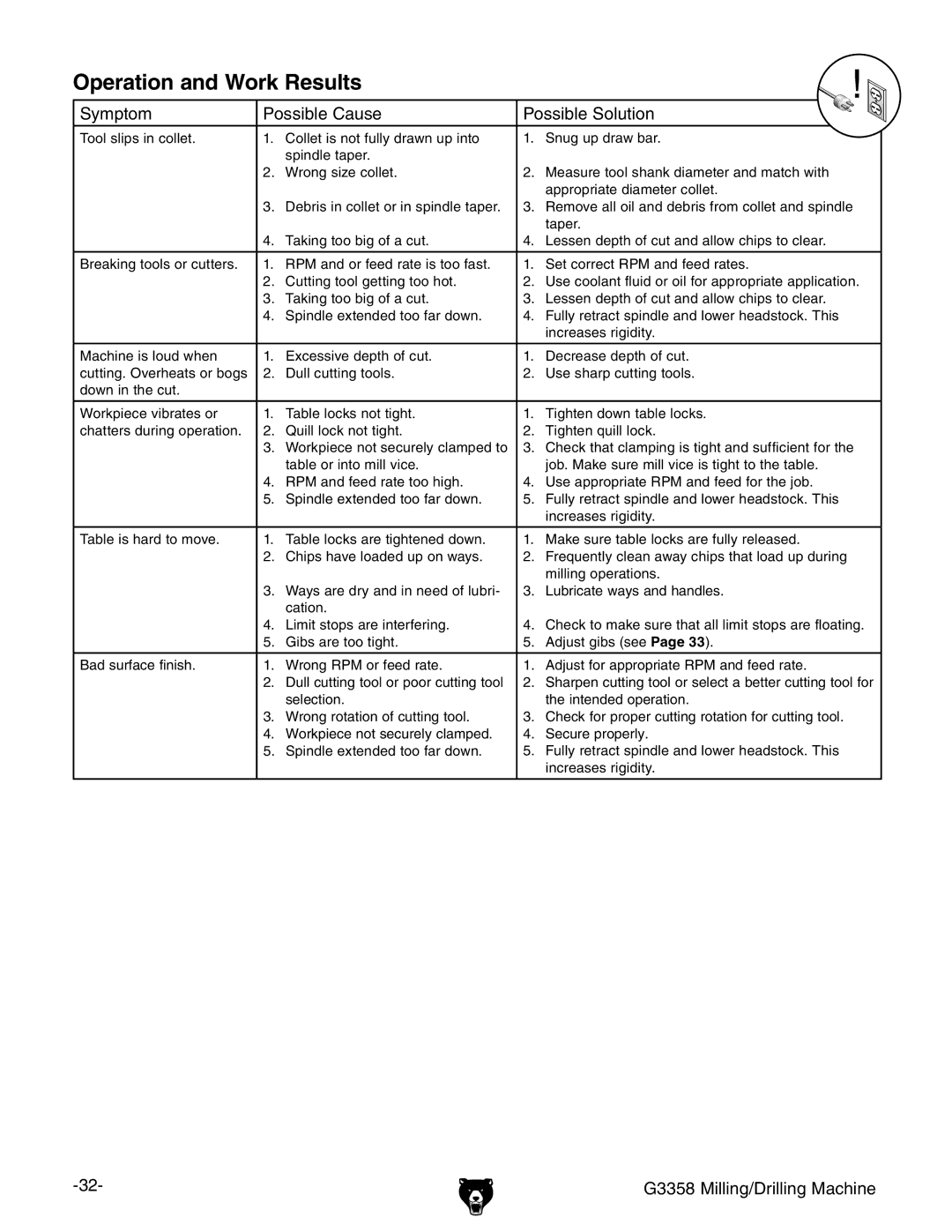
Operation and Work Results
Symptom | Possible Cause | Possible Solution | ||
Tool slips in collet. | 1. | Collet is not fully drawn up into | 1. | Snug up draw bar. |
|
| spindle taper. |
|
|
| 2. | Wrong size collet. | 2. | Measure tool shank diameter and match with |
|
|
|
| appropriate diameter collet. |
| 3. | Debris in collet or in spindle taper. | 3. | Remove all oil and debris from collet and spindle |
|
|
|
| taper. |
| 4. | Taking too big of a cut. | 4. | Lessen depth of cut and allow chips to clear. |
|
|
|
|
|
Breaking tools or cutters. | 1. | RPM and or feed rate is too fast. | 1. | Set correct RPM and feed rates. |
| 2. | Cutting tool getting too hot. | 2. | Use coolant fluid or oil for appropriate application. |
| 3. | Taking too big of a cut. | 3. | Lessen depth of cut and allow chips to clear. |
| 4. | Spindle extended too far down. | 4. | Fully retract spindle and lower headstock. This |
|
|
|
| increases rigidity. |
|
|
|
|
|
Machine is loud when | 1. | Excessive depth of cut. | 1. | Decrease depth of cut. |
cutting. Overheats or bogs | 2. | Dull cutting tools. | 2. | Use sharp cutting tools. |
down in the cut. |
|
|
|
|
|
|
|
|
|
Workpiece vibrates or | 1. | Table locks not tight. | 1. | Tighten down table locks. |
chatters during operation. | 2. | Quill lock not tight. | 2. | Tighten quill lock. |
| 3. | Workpiece not securely clamped to | 3. | Check that clamping is tight and sufficient for the |
|
| table or into mill vice. |
| job. Make sure mill vice is tight to the table. |
| 4. | RPM and feed rate too high. | 4. | Use appropriate RPM and feed for the job. |
| 5. | Spindle extended too far down. | 5. | Fully retract spindle and lower headstock. This |
|
|
|
| increases rigidity. |
|
|
|
|
|
Table is hard to move. | 1. | Table locks are tightened down. | 1. | Make sure table locks are fully released. |
| 2. | Chips have loaded up on ways. | 2. | Frequently clean away chips that load up during |
|
|
|
| milling operations. |
| 3. | Ways are dry and in need of lubri- | 3. | Lubricate ways and handles. |
|
| cation. |
|
|
| 4. | Limit stops are interfering. | 4. | Check to make sure that all limit stops are floating. |
| 5. | Gibs are too tight. | 5. | Adjust gibs (see Page 33). |
|
|
|
|
|
Bad surface finish. | 1. | Wrong RPM or feed rate. | 1. | Adjust for appropriate RPM and feed rate. |
| 2. | Dull cutting tool or poor cutting tool | 2. | Sharpen cutting tool or select a better cutting tool for |
|
| selection. |
| the intended operation. |
| 3. | Wrong rotation of cutting tool. | 3. | Check for proper cutting rotation for cutting tool. |
| 4. | Workpiece not securely clamped. | 4. | Secure properly. |
| 5. | Spindle extended too far down. | 5. | Fully retract spindle and lower headstock. This |
|
|
|
| increases rigidity. |
|
|
|
|
|
G3358 Milling/Drilling Machine |
